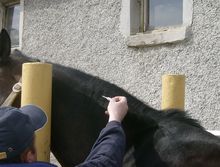Until recently, horses were generally branded to identify individual animals. Since this practice gives rise to long standing wounds and brand marks cannot be reliably read, there has been a gradual switch towards the use of microchips.

Implanting a microchip in a horse
Researchers concluded that not only is chipping a far more reliable method for marking horses than traditional methods of branding, they also found it causes far less injury to the animals.
© 2013 by Izvora
But how reliably can microchips be located and read, and are the horses injured by having chips implanted?
These issues have been addressed by the team of Christine Aurich in a study at the University of Veterinary Medicine, Vienna.
As reported in The Veterinary Journal, chips are highly biocompatible and easy to read, at least with scanners of high quality.
With very few exceptions, it is now mandatory within the European Union to mark horses by means of transponders. Nevertheless, some sport-horse registries oppose the use of microchips because they believe that the rate of identification failure is unacceptably high.
Manuela Wulf in the group of Christine Aurich at the Vetmeduni Vienna has therefore examined the readability of microchips in more than 400 horses. She tested each of the chips with three different scanners. The scanners differed in diameter and field strength. The scientists tested both sides of the animals' necks.
Only high quality scanners are recommended
The results were intriguing. The "best" scanner equipped with a digital signal processing function that filters interfering signals detected and read all chips correctly when it was placed on the side of the neck where the chip was implanted and located nearly 90% of the chips when it was on the other side of the neck.
However, the other two scanners performed considerably less well, producing correct reads in around 90% of the cases when on the same side of the neck.
On the opposite side of the neck, the success rate ranged between 20-25%. As Wulf puts it, "It is important that the scanners find and read the chips correctly in every case. We can only recommend the top-of-the-range scanner, which should ideally be placed on the side of the horse's neck where the chip was implanted."
However, Aurich adds, "Even the lowest quality scanner we tested, performed much better than traditional branding methods of horse identification."
Chipping causes less injury to horses than branding
The major objection to the use of branding relates to the pain and long-term damage it inflicts on the animals. Wulf and her colleagues thus investigated whether the use of microchip markers was any better.
Looking closely at the site of chip implantation in 16 horses of nine different breeds and of various ages that had been submitted to the Vetmeduni for post mortem examinations: In the vast majority of cases, the chips seemed to have caused absolutely no ill effects. The two animals that were moderately affected had probably only been chipped recently and there had not yet been time for the wound to heal.
As Aurich sums up the findings, "Not only is chipping a far more reliable method for marking horses than traditional methods of branding, we also found that it causes far less injury to the animals."
